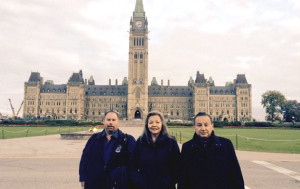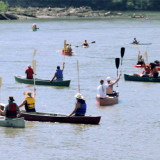
B.C. First Nations chiefs recently travelled to Ottawa to urge the federal government to pull the plug on the costliest infrastructure project in the country. At an estimated $7.9 billion and growing, the proposed Site C Dam on the beautiful Peace River in northeastern B.C. has been criticized for spiralling costs, questions about whether the electricity it would produce is even needed, and concerns about the environmental and social impacts of flooding thousands of hectares of prime farmland, irreplaceable cultural sites and wildlife habitat. The government is expected to make a decision in October.
[quote]If built, Site C would violate First Nations’ rights under Treaty 8, rendering them irrelevant to the point of mockery.[/quote]
Treaty 8 rights at risk

While in Ottawa, First Nations leaders also reminded politicians that the Peace River Valley is the traditional territory of the Dane-zaa, and Canada has clear obligations to them under the 1899 Treaty 8. Years of case law, as well as the recent Supreme Court of Canada Tsilhqot’in decision, confirm that First Nations must have a say on industrial development on their lands.
If built, Site C would violate First Nations’ rights under Treaty 8, rendering them irrelevant to the point of mockery. Treaty 8 guarantees First Nations the right to hunt and fish “for as long as the sun shines, the rivers flow and the grass grows.” But are treaty promises even worth the paper they’re written on when hunting grounds will be drowned under water, moose populations decimated and fish contaminated with toxic methyl mercury from decaying vegetation?
Site C would also obliterate hundreds of graves and ceremonial sites, and so hinder cultural and traditional practices. Hunting, fishing, collecting medicinal plants and visiting sacred sites are activities by which First Nations maintain their cultural and spiritual identity and connection to the land. How long will Treaty 8 First Nations be able to sustain a vibrant, living culture when the dam devastates their land and communities?
“Significant adverse effects”
These questions are not hypothetical. A Joint Review Panel, convened by the federal and B.C. governments, concluded Site C would significantly harm Treaty 8 First Nations. The panel found the dam would have “significant adverse effects” on fishing, hunting and trapping, and on other traditional land uses — and not just in B.C., but downstream where the Peace River enters Alberta. According to the panel, most of these adverse effects would be impossible to mitigate.
Peace Valley’s unique natural assets
In standing up for the Peace Valley and saying “no” to the Site C Dam, Treaty 8 First Nations’ leaders are acting not only on their own behalf, but also for other Canadians, including local farming communities with which they have co-existed for generations. Together, these rural communities are reminding the government and the rest of us that the Peace Valley offers immense bounty and natural wealth through fishing, hunting and potential for food production, and is too valuable to be sacrificed for industrial development.
A recent study by David Suzuki Foundation economists also found that, each year, the Peace River Valley and surrounding areas provide billions of dollars in beneficial ecological services like pollination, water filtration and flood control.
[signoff3]
The Peace Valley has productive soils and a unique microclimate ideally suited to producing a wide range of crops. According to three senior agricultural experts who testified before the Joint Review Panel, the east-west Peace River Valley’s deep alluvial soils, long northern daylight in the growing season and microclimate for agriculture could produce fruits and vegetables to meet the nutritional needs of over a million people a year!
The California drought this past summer reminds us that relying on imported food makes us vulnerable. B.C. already imports over 57 per cent of the fresh vegetables British Columbians consume each year, much of which could be grown in the province. The situation is similar elsewhere in Canada.
Recent court cases are a wake-up call for politicians. When it comes to decisions that could irrevocably affect them, the days of running roughshod over First Nations are over. B.C.’s Treaty 8 First Nations have already borne the brunt of decades of industrial development on their lands, including two earlier Peace River dams. They have also found common cause with local communities fighting to save family farms and ranches.
Building the Site C Dam and flooding the Peace Valley would be more than folly; it would be a tragedy for First Nations, agriculture and the environment.
Written with contributions from David Suzuki Foundation Ontario and Northern Canada Director-General Faisal Moola.


Phoney man!!! All about money! Very easy for him to be nasty when he lives in a 8 million dollar home!!!! PHONEY PHONEY!!!!!
https://www.change.org/p/the-concerned-citizens-of-british-columbia-ask-for-the-resignation-of-premier-christy-clark
Yes, all completely true, especially when you consider that the number one reason why the corpogovernment wants this abomination is to generate power for the mega industrial projects, particularly fracking, that they are determined to push through. We can only hope and pray that the deal with China that’s being signed in Ottawa today won’t negate all the hard work that has gone into stopping this awful project project so far. And if it does, we just have to double down our efforts. This dam must NOT be allowed to be built. Period